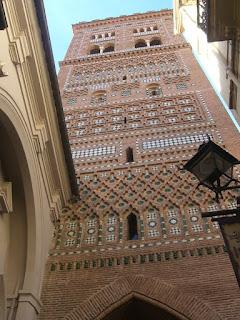 |
The entrance to the fortress-like city of Teruel features a depiction of the young lovers Juan Diego de Marcilla and Isabel de Segura Teruel.
|
Ceramic’s Role in Mudejar Art
As a center for Mudejar art, a style influenced by Islamic tradition and more contemporary European architectural styles, the fortress-like city is characterized by its extensive use of brick and ceramic tile not only within the centuries-old structures, but also on their façades.
 |
| This brick and ceramic tile staircase leads to the city of Teruel. |
According to UNESCO, the Mudejar art in the Aragon region developed as a result of the Christian Reconquest in the early 12th century. Following a series of campaigns to recapture territory from the Moors, such as in Spain and Portugal, Christians of the region allowed the Moors to remain on the reconquered territories, going so far as to allowing the Moors to keep their own culture and religion, most importantly, their expression of art.
Because of the symbiotic relationship between Gothic style and Muslim influences, Mudejar art and architecture flourished in the Teruel region, as can be seen in this picturesque city’s churches and cathedrals, most notably the cathedral tower (1257), the tower of the church of La Merced (late 16th century), the tower of San Martin (1315), the tower of the church of San Pedro (14th century), and the tower of the church of El Salvador (12th-13th centuries). Further examples of the importance of glazed ceramic tile products as a building material are not only evident on these graceful towers, but also throughout this enchanting historical city.
 |
| The tower of El Salvador features multiple levels of white and green ceramic tiles. |
 |
| The breath-taking view from the top of El Salvador’s tower. |
The twin tower of San Martin, El Salvador, dates from the beginning of the 14th century, although it was rebuilt in 1677 after it collapsed. The tower has several levels bordered with tiling in rhomboid patterns, borders and semi-circular arches, decorated with white and green tiles.
 |
| Here's an up-close look at the various shapes and sizes of the white and green ceramic tiles used throughout the city of Teruel. |
In my next post, I’ll take you on a journey to Valencia, where Cevisama, (the International Ceramic Tile and Bath Furnishings Show) is held annually. In the meantime, you can check out the beautiful hand-painted ceramic Spanish tiles offered by Avente Tile.
Many thanks to Tile of Spain, the umbrella brand managed jointly by the Trade Commission of Spain in Miami, FL, and the Spanish Ceramic Tile Manufacturer’s Association (ASCER) in Valencia, Spain, for the opportunity in participating in their “Reign in Spain A&D Tour.”




2 comments:
Great posting! Today there are so many variety in tiles that people are thinking to have more stylish piece for there home.
Green Tiles
Thank you for your positive feedback, Zoya. Much appreciated!
Post a Comment